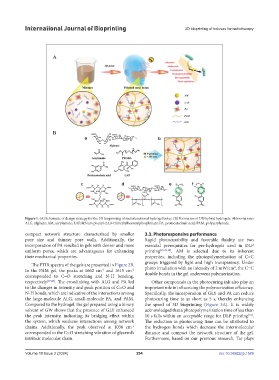Page 262 - IJB-10-2
P. 262
International Journal of Bioprinting 3D bioprinting of boluses for radiotherapy
Figure 1. (A) Schematic of design strategy for the 3D bioprinting of multifunctional hydrogel bolus. (B) Formation of DN hybrid hydrogels. Abbreviations:
ALG, alginate; AM, acrylamide; LAP, lithium phenyl-2,4,6-trimethylbenzoylphosphinate; PA, protocatechuic acid; PAM, polyacrylamide.
compact network structure characterized by smaller 3.3. Photoresponsive performance
pore size and thinner pore walls. Additionally, the Rapid photocurability and favorable fluidity are two
incorporation of PA resulted in gels with denser and more essential prerequisites for pre-hydrogels used in DLP
uniform pores, which are advantageous for enhancing printing [25,29,30] . AM is selected due to its inherent
their mechanical properties. properties, including the photopolymerization of C=C
The FTIR spectra of the gels are presented in Figure 2B. groups triggered by light and high transparency. Under
2
In the PAM gel, the peaks at 1662 cm and 1615 cm photo irradiation with an intensity of 2 mW/cm , the C=C
-1
-1
corresponded to C=O stretching and N-H bending, double bonds in the gel underwent polymerization.
respectively [27,28] . The crosslinking with ALG and PA led Other compounds in the photocuring ink also play an
to the changes in intensity and peak position of C=O and important role in influencing the polymerization efficiency.
N-H bonds, which are indicative of the interactions among Specifically, the incorporation of GLY and PA can reduce
the large-molecule ALG, small-molecule PA, and PAM. photocuring time to as short as 5 s, thereby enhancing
Compared to the hydrogel, the gel prepared using a binary the speed of 3D bioprinting (Figure 3A). It is widely
solvent of GW shows that the presence of GLY enhanced acknowledged that a photopolymerization time of less than
the peak intensity, indicating its bridging effect within 10 s falls within an acceptable range for DLP printing .
[31]
the system, which weakens interactions among network The reduction in photocuring time can be attributed to
chains. Additionally, the peak observed at 1036 cm the hydrogen bonds which decrease the intermolecular
-1
corresponded to the C=O stretching vibration of glycerol’s distance and compact the network structure of the gel.
intrinsic molecular chain. Furthermore, based on our previous research, Tar plays
Volume 10 Issue 2 (2024) 254 doi: 10.36922/ijb.1589

